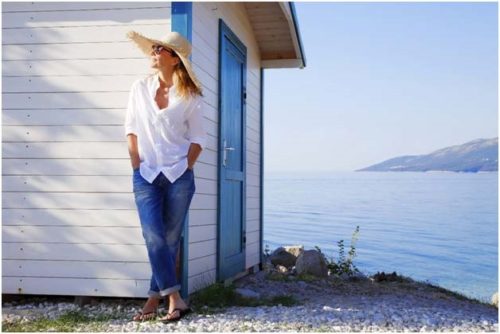Turn a Vacation Home to Forever Home
Aging in (a fun) Place with Lifespan Design
On a recent trip to a coastal town that is a retirement destination, we noticed not a single house had any consideration of aging-in-place design. This got me thinking about Peter Pan Housing…
Peter Pan Housing
Environmental gerontologists and Certified Aging in Place Specialists (CAPS) remodelers call homes that are designed for young able-bodied people (like most all vacation homes) “Peter Pan Housing.” The reason is that most second homes in resort or vacation destinations don’t consider growing old when they are designed. They have hilltops views, stairs to decks, narrow doorways, and barriers to thresholds for entering, and they are often secluded…meaning isolated from services–because they are designed to “get-away-from-it-all! Great for solitude, but not so good for aging bodies if you want to live there in retirement.
In an article titled: Aging U.S. Baby Boomers Face More Disability, researchers report a new pattern of rising disability among pre-retiree baby boomers, the trend showed rising disability levels among those nearing retirement age (ages 55 to 64) and flat trends for those ages 65 to 84. “Troubling,” is what Martin, who has long tracked disability patterns, called the trends. “These are the members of our future older population.”
The numbers may be a bit sobering, but not to fear, if you want to turn that vacation home into your future “forever home” there are steps you can take now to make that happen.
Step 1
Design with a Zero-step Entrance
A zero-step entrance is just like it sounds, there is no barrier to entering the home. No steps, no curbs, no thresholds, no lips, the entryway is flat and flush with the home’s interior. This allows a seamless path into the home for wheelchairs, elders, kids, moms with strollers, dads with broken legs on crutches, etc. By the way, any entry will do, front, back, or sides, just so you can get into the dwelling.
This non-barrier entry must have a level landing outside of the door to give room for a walker or wheelchair to rest without rolling away. The entry area should also be covered so that you have protection from the weather as you search for your keys or wait for the door to be answered. Lighting for safety and a bench to put down your belongings while you are opening the door are must-have additions.
In addition, if you are aging-in-place modifying your vacation home to create a zero-step entry, connecting it to your driveway, garage or street parking area helps a person get from their vehicle to the home. And selecting the entry that has the least height difference between the inside and the outside surface will save money and effort.
Step 2
Widen doorways 32-36 inches
Let’s start at the bathroom door. Architects design and build a 24″ door to the bathroom, which is not age-friendly. The humorist, Erma Bombeck once said: Sometimes I can’t figure designers out. It’s as if they flunked human anatomy. This is so true, wheelchairs need a minimum 32″ door for a straight-in approach. If the doorway is in the typical hallway and requires turning a wheelchair, you’ll need a 36″ door. So, it would be wise to widen doors now so that in the future your vacation home will be accessible to all who want to visit. Not to mention for you should the need arise.
Try Stone Harbor Hardware, 3.5-inch Swing Clear Offset Door Hinge (Satin Chrome)
Benefits: Accessibility doorways without the remodel.
~Door swings completely outside of jamb adding width to existing door openings
~Provides barrier-free access
~Works on left-hand or right-hand doors by a flipping hinge pin
~Includes two hinges and matching screws
~Fits 1 3/8-inch to 1 3/4-inch thick doors. This is a 3 1/2-inch hinge with a 5/8-inch corner radius.
Step 3
Build a half bath, preferably a full bath, on the main floor that’s Universal Design/accessible
A bathroom that’s accessible on the main floor is fundamental to any vacation “forever home” (or any home for that matter). With the population aging, a bathroom on the main floor will ensure that your home will be in high demand. The age-friendly aspect of not having to climb stairs to use the restroom will be a tremendous benefit now and into the future.
Step 4
Stay Fit.
You can take the time to be healthy or you have to make the time to be sick.
These 3 inclusive-design modifications are collectively known as “Visitability” because with them anyone can now visit and share your home. Lifespan design elements like these will go a long way towards ensuring a “forever vacation home” will be enjoyed by all for many years to come.
Getting the Work Done
Go to Certified Aging in Place (CAPS) Remodelers to find a CAPS remodeler who can do the job.
________________________________________________________________________________________________
Additional Resource: NAIPC National Aging in Place Council

